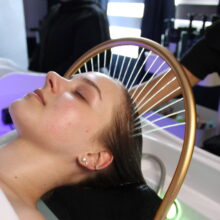Spa Science: Evidence Behind the Therapies
- Published: Thursday, November 1st 2012
- in Living Well

With the launch of the new website SpaEvidence.com this year — the world’s first portal to the aggregated medical studies that exists for 21 common spa/ wellness approaches — that trend was literally embodied. Launched by the Global Spa Summit in mid-2011 (an advocacy group for the worldwide spa/ wellness industries), and shaped by doctors with an expertise in integrative medicine, SpaEvidence gives the world easy access to the “evidence-based medicine” databases that doctors use, so they can search thousands of studies evaluating which spa modalities are proven to work, and for which exact conditions.
SpaEvidence represented a big, courageous step towards transparency for the spa industry, as the site presents the clinical evidence behind therapies, whether it is positive, inconclusive or negative. And it forged new, common ground between the medical and spa worlds by embracing the rigors of evidence-based medicine.
For 2012, we name a trend after this breakthrough website because the “fact” of its appearance so neatly encapsulates a macro shift that is quickening: the continued breakdown of the once separate silos of traditional medicine and complementary/spa therapies. And the erosion of these silos, the “Spa Evidence” trend, will take diverse forms in the year ahead…some ongoing, some new.
In 2012, more hospitals than ever before will incorporate — and more doctors will prescribe — spa and wellness approaches, not only because more new research shows that mind-body treatments can be especially effective for chronic pain, heart disease, sleep disorders and depression/anxiety, etc., but because the sheer global costs of not focusing on prevention have passed the tipping point. (Spending on healthcare amongst OECD and BRIC nations will grow 50 percent-plus from 2010 to 2020.⁸)
Consider changes underway in the prevention-challenged U.S. healthcare system: A new study⁹ reveals that the number of hospitals offering alternative/spa services has tripled since 2000 (from 14 percent of hospitals, to 42 percent today).
Roughly two in three of these hospitals now provide massage, three in five offer acupuncture and music/art therapy and one in five provide reiki.
Hospitals report footing the bill 44 percent of the time, and at Pritikin (one of the premier weight-loss/heart-health American spa resorts), qualified people now get their trip covered by Medicare. Another new study¹⁰ finds that of the 41 million Americans that use mind-body therapies like yoga or tai chi, 6.4 million are now doing them because they were prescribed by their medical provider.
More hard evidence of Spa Evidence: The National Institutes of Health has nearly doubled its grants for complementary and alternative medicine from 2007-2011. And Medicare, the U.S. government’s health insurance program for all people over 65, has just announced it will cover screening and counseling for obesity, which, as Dr. Patrick Conway, the program’s spokesperson, noted, was a result of it “systematically reviewing the best possible medical evidence to identify those preventative services that can keep (people) as healthy as long as possible.”
A striking new example of hospitals blending medicine/spa: fashion icon Donna Karan’s Urban Zen Integrative Therapy program, expanding across major U.S. hospitals like UCLA Medical Center.
Frustrated by the lack of “eastern healing” approaches during her husband’s cancer treatment, Karan designed the program to train medical professionals in yoga therapy, reiki, essential oil therapy, nutrition and contemplative care.
Other manifestations of the trend: more global spa/wellness businesses broadcasting the medical evidence that exists for what they do (in marketing messages, client communications, etc.); more incorporating SpaEvidence.com into their own site; and more adopting the language of evidence-based medicine.
Big spa players like Rancho La Puerta (Mexico), Fairmont’s Willow Stream Spas (across Asia, Europe, North America, etc.) and Spafinder. com (global) have adopted a custom version of SpaEvidence.com; spas from Gwinganna Lifestyle Retreat (Australia) to Quantum Spa (South Africa) prominently link to the site; and many spas like Jumeirah Resorts’ Talise spas from Dubai to Shanghai have adopted the language of “evidence-based medicine” to describe their offerings.
“Seventy-one percent of people report they would be more likely to visit spas if they had access to scientific studies demonstrating treatments deliver measurable health benefits.”
SRI InternatiOnal, Spas & the Global Wellness Market Report, 2010
As more people digest the medical evidence for alternative/spa therapies (and the realities that some evidence is strong, some negative, and that many more studies need to happen), the conversations — “no alternative therapies work” or “no traditional medicine is good” — will continue to become less shrill and divisive.
In fact, distinct, new conversations are emerging, well expressed by Dr. Jay Parkinson, named one of the ten most creative people in healthcare¹¹: “The companies that realize the future of health is about life and happiness rather than sickness, death and medical solutions, are the ones that will lead in the next decade.”
There are now new medical studies, like the one just released by University College, London, showing that happy people reduce their risk of premature death by as much as 35 percent¹².
And the conversations around concepts like “happiness,” the quality of a lived life, true wellbeing (both physical and mental) and the value of pleasure are really heating up.
More governments are measuring “happiness” along with GNP; the UK and France performed national “happiness indexing” studies in 2011.
More “happiness movements” are afoot like the UK’s “Action for Happiness,” which organizes to promote “the pillars of happiness”: physical/mental wellbeing, relationships and giving.
Books like renowned psychologist Dr. Martin Seligman’s Flourish: A Visionary New Understanding of Happiness and Well-Being are generating buzz for exploring how true “health” is much more than the absence of illness and is comprised of both subjective and biological “assets.”
Once seemingly intangible concepts like “happiness” are becoming a field of scientific inquiry because the medical research backs the approach.
As the medical evidence for prevention, more truly holistic concepts of wellbeing — and now, even “happiness” — escalates, it’s a huge opportunity for the spa industry.
SOURCES
- PricewaterhouseCoopers Health Research Institute Data, 2010 [9] American Hospital Assn./Samueli Institute Report, 2011
- Archives of Internal Medicine, 2011
- Named by Fast Company Magazine
- Published: Proceedings of the National Academy of Sciences, 2011
TOP 10 SPA & WELLNESS TRENDS FOR 2012
- Feet Focus: Healthy Feet Treatments
- Cold and Ice Are Hot
- Wellness and Beauty Coaching
- Online Wellness Gaming
- Pairing Fine Dining and Spa-ing
- Vibration, Sound, Music, Light and Color
- The Glam Factor: Glambition
- Spa Evidence
- Spas Become a Family Affair
- Spas Go for the “Wow”



